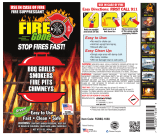
5. If the kettle is a tilting model, tilt the
kettle forward. The red "low water" light
should be lit when the kettle is in a tilted
position. This light indicates that the
heater elements are not submerged in
water, and they have automatically been
shut off by the kettle's safety circuit. This
is a normal conditon when kettle is in a
tilted position.
6 Lower the kettle to the upright position.
The red "low water" light should go out
when the kettle is upright. If the red light
remains lit in the upright position, it
indicates a low water condition, and water
must be added to reservoir before the
kettle can be operated. Refer to the
"Reservoir Fill Procedures", on the kettle's
label, for details.
7. Turn the temperature control knob to
"max." and allow the kettle to preheat.
The green light should remain on until the
set temperature is reached (260°F/127°
C), then cycle on and off with the
thermistor. Fill the kettle with cold water
to the steam jacket's welded seam. Refer
to the chart below for the time required to
bring the water to a boil.
8. When all testing is complete, empty the
kettle and place the power on/off switch
in the "off" position.
The accompanying chart shows
approximate times required for electric
kettles of various capacities to boil water.
Temperature control knob must be set at
"Max." throughout the heatup period.
Water will boil about 1/3 faster if the
kettle is filled only to the outer steam
jacket's welded seam, resulting in a kettle
filled to 2/3 capacity.
KETTLE VENTING INSTRUCTIONS
If the vacuum/pressure gauge reading is in the
"vent air" zone, it means that the air has entered
the steam/water jacket, resulting in little or no
vacuum. Air inside the jacket will act as an
insulator therefore reducing kettle efficiency. To
remedy this situation, the following venting
procedures should be followed:
1. With the temperature control knob set at
number 6 or 7, heat the empty kettle
until the vacuum/pressure gauge
indicates 5-10 psi.
2. Release steam and air from the
steam/water jacket by loosening, one-half
turn, the 7/16 inch chrome-plated brass
venting valve nut (located at the rear of
the kettle) for 10-15 seconds.
3. Tighten the vent valve nut, being careful
not to overtighten.
The kettle's steam/water jacket should now be
free of air. At room temperature, the pressure
gauge needle should rest in the green zone,
indicating a vacuum in the kettle's jacket.
3


























